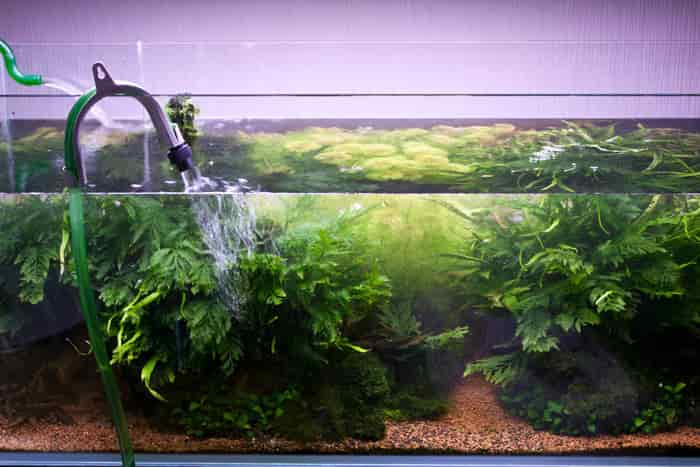How often does the water in the aquarium need to be changed? What should I watch out for when changing the water? Which conditioners do I have to use? Questions like these are often asked, especially by beginners. If you have a little experience in aquaristics, you will soon find the right method for changing the water for your aquarium – our tips give you a start and answer the most important questions on the subject.
Why do I need to change the water in the aquarium?
Many beginners ask themselves: Why do I have to change the water in the aquarium at all? Doesn’t the filter keep it clean enough? That’s not quite right: The filter serves to filter particles out of the water that make it cloudy. This keeps the aquarium water crystal clear. Above all, however, it has the function of biological filtration: nitrifying bacteria settle on the filter material. They ensure that the water quality is maintained. If you would like to know more about how this works, read more about the nitrogen cycle in our article Nitrate in the aquarium.
In addition to regular water changes in the aquarium, dense and healthy planting is essential for good water quality and stable water parameters.
Better water quality in the aquarium: fast-growing plants
Fast-growing aquarium plants are particularly well suited to maintaining the water quality between water changes in the aquarium: they absorb excess nutrients from the water. This significantly reduces the risk of an algae plague in the aquarium – even if you don’t manage to change the aquarium water in time.
For example, Egeria densa, the waterweed, whose German trade name already indicates its growth characteristics, is unbeatable when it comes to growth. Hardly any aquarium plant is as easy to care for and as fast-growing as it is.
Discover more fast-growing aquarium plants in our Fast-growing aquarium plants article or browse our aquarium plant shop!
However, the plants in the aquarium cannot keep the biological cycle going on their own. Regular water changes are necessary to B. Remove nutrients and debris that accumulate from the aquarium. Therefore, even in a lushly planted aquarium, the water must be partially replaced at regular intervals.
Water change in the aquarium: how often is it necessary?
A rule of thumb is: the water in the aquarium should be changed about every 14 days. This rule applies to a normal community aquarium. Of course, completely different intervals are conceivable for special tanks, such as rearing facilities. Some aquarists also swear by doing weekly water changes in smaller amounts.
Tip: Changing the water can easily be combined with caring for the plants in the aquarium.
Basic rule: It is better to change a small amount of water in the aquarium more often than a large amount of water infrequently. The larger the tank, the more stable the water values and the more likely it is that a water change will be “forgiven” – since the biological balance in large aquaria shakes less quickly.
How much water should I change in the freshwater aquarium?
You should change about a good third of the water in the aquarium. If you change too much water, there will quickly be an imbalance in the aquarium – the values change too suddenly. Depending on the water parameters, this can have serious consequences. Animals and plants suffer from the sudden change in conditions.
A large water change of half or more of the tank volume is only carried out in emergencies: if the water is contaminated with germs, to combat algae in the aquarium or to quickly remove toxins from the water – for example if shrimp suddenly die in the aquarium. This is a rather drastic measure that you should only take if it is really necessary.
Water change in the aquarium: step by step
Regular water changes quickly become a routine part of regular aquarium maintenance.
Water change – what you need:
- Hose for sucking off the aquarium water
- Mulm bell for cleaning the aquarium floor (if required)
- Buckets for collecting and transporting the water
- Disc magnet or scraper for cleaning the aquarium glass
- Rag or towel for spilled water
Preparation
Prepare all the utensils you need. Since water changes are rarely drip-free, we advise you to have a rag or an old towel handy. This is how you avoid water stains on the base cabinet. Now switch off the aquarium technology. Above all, the filter and the heater, which are under water, should be switched off before reaching into the aquarium. A defect can otherwise result in a dangerous electric shock.
Clean the aquarium panes
The water change is usually combined with cleaning the aquarium and the panes – these are first freed from algae with a suitable accessory. A light coating of green algae on the aquarium pane is normal. Regular cleaning ensures a good view of the tank, the aquarium plants and of course the inhabitants such as fish or invertebrates.
Water change with mud bell (optional)
If you use a mulch bell, you can clean the bottom of the aquarium particularly easily: changing the water and cleaning is done in one step. If you want to leave the sludge corners in your aquarium floor – for example in an aquarium for shrimps – it is sufficient if you remove coarse dirt and dead plant parts with a net or aquarium tweezers.
Water change with the hose
If you change the water in the aquarium using the hose (with or without a mulch bell), proceed as follows: The bucket is provided – make sure that it is lower than the water level in the aquarium. Then insert one end of the hose into the pool. Now suck the air out of the hose with your mouth briefly. The water starts to flow into the hose. Now you can easily let it run into the bucket. Surely every aquarist has accidentally taken a sip of aquarium water at some point, but you will soon find out the trick.
Tip: Use a light-colored bucket. It quickly happens that a fish or a shrimp is sucked up unnoticed. A scrutinizing look into the bucket prevents the worst when disposing of the old water.
Fill the aquarium with fresh water
The fresh tap water should definitely have the same temperature as the water in the aquarium. A slight deviation of one to two degrees is fine. Place the water in the bucket, condition it if desired, and slowly pour it into the aquarium. A small plate on the ground prevents it from being whirled up.
Which water do I use for changing the water in the aquarium?
For a normal community aquarium, the aquarium water is replaced with normal tap water. This is mixed with water conditioners and fertilizer for the aquarium as required. If you have water in your region that is very hard, or if you care for animals or plants with special requirements, you may have to treat it using other methods, such as an osmosis system. However, this is a topic for advanced aquarium owners. This is usually not necessary for an ordinary community tank.
We hope that with our tips on changing the water in the aquarium we have been able to give you a little help for the fascinating hobby of aquaristics. Have questions or comments? We look forward to your comment!





